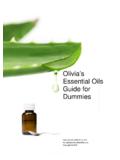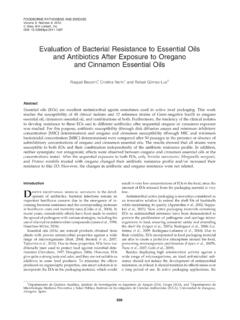Transcription of Ten Essential Oils for Beech Wood Protection - Efficacy ...
1 PEER-REVIEWED ARTICLE P nek et al. (2014). Essential oil modified wood, BioResources 9(3), 5588-5603. 5588 Ten Essential oils for Beech Wood Protection - Efficacy Against Wood-destroying Fungi and Moulds, and Effect on Wood Discoloration Milo P nek,a,* Ladislav Reinprecht,b and Matej Hulla b This work analyses the anti-fungal Efficacy and stability of 10 Essential oils , as well as their colour stability, in wood. The Efficacy of oils against the decay fungi Coniophora puteana and Trametes versicolor as well as the moulds Aspergillus niger and Penicillium brevicompactum was evaluated first on filter papers treated with 1, , 10%, or 100% concentrate, and then on Beech wood treated with 10% solutions.
2 Accelerated ageing of treated Beech samples was done before mycological tests and consisted of heating, leaching followed by heating, and Xenotest followed by heating. The highest growth inhibition of moulds and C. puteana was caused by thyme, oregano, sweet flag, and clove oils , while the savory and birch oils were less effective. These oils are potentially useful for wood Protection against brown-rot fungi and moulds, mostly in interior conditions. The Essential oils had only a negligible effect against the white-rot fungus T. versicolor, which was more apparent after previous ageing of wood. Some Essential oils with a yellow tone (birch, oregano, sweet flag, savory, and tea tree oils ) significantly changed (p< ) the natural colour of Beech wood, but the new colours were relatively stable and underwent only mild changes after accelerated ageing in Xenotest.
3 Keywords: Wood Protection ; Essential oils ; Wood-destroying fungi; Moulds; Colour Contact information: a: Czech University of Life Sciences Prague, Faculty of Forestry and Wood Sciences, Kam ck 129, 165 21 Prague 6 Suchdol, Czech Republic; b: Technical University in Zvolen, Faculty of Wood Sciences and Technology, Masarykova 24, 960 53 Zvolen, Slovak Republic; * Corresponding author: INTRODUCTION Many wood preservatives that are effective against decay and mould attacks (containing heavy metals such as Cr, As, and Sn) have been prohibited in many countries in recent years (Reinprecht 2010) due to their negative effects on human health (risks of cancer, foetus defects, liver and kidney damage, neuropathic changes, asthma, and various allergic reactions) as well as ecological problems during service-life, particularly during the disposal of such products.
4 However, common types of wood in a natural state are degraded by microorganisms in a relatively short time. Therefore, researchers are looking for new compounds and wood Protection methods with little or no negative ecological and human health impacts. New ways of wood Protection against pests can be necessary after possible prohibition of presently used biocides. For example, modified wood is already widely used, , thermally treated wood (Militz 2002; Schwarze and Spycher 2005; Hill 2006), furfurylated wood (Lande et al. 2006), acetylated wood (Westin et al. 2004; Hill 2006), natural chitosan treated wood (Schmidt and M ller 1995; PEER-REVIEWED ARTICLE P nek et al.)
5 (2014). Essential oil modified wood, BioResources 9(3), 5588-5603. 5589 Chittenden et al. 2004; Maoz and Morrell 2004), or wood treated with lignins against brown-rot (Chirkova et al. 2011). Biological methods for Protection of wood, also on a commercial basis, include using the antagonistic effect of some microscopic fungi and bacteria against more dangerous wood-destroying fungi (Kim and Morrell 1998; Score et al. 1998; Tiralov et al. 2007). It is more common to use natural products from plants or extractives from very durable wood species , tannins, flavonoids, or terpenoids (Huang et al. 2004; Amusant et al.
6 2005; Asamoah and Antwi-Boasiako 2007), extracts from chili with the effective compound capsaicin (Singh et al. 2006), or propolis with an antibiotic effect (Budija et al. 2008). The cited works have shown the potential of natural substances for wood Protection against decay fungi, moulds, or insects. An interesting method of wood Protection is the use of Essential oils and their effective compounds from plants having known anti-fungal, insecticidal, and anti-bacterial effects. This method has many advantages: (1) Plants can be produced in large amounts as agricultural products (renewable resource); (2) Some oils can combine anti-fungal, insecticidal, and anti-bacterial effects; (3) Essential oils are health-friendly (many of them are used in medicine, aromatherapy, and cosmetics), and they cause only small problems in terms of liquidation of treated products after their service-life.
7 Some disadvantages of using Essential oils for wood Protection are their high volatility and non-stable concentrations of effective compounds (Batish et al. 2008). Efficacy of Essential oils against wood-destroying fungi, wood-staining fungi, and moulds was searched already in some scientific works. Mohareb et al. (2013) isolated Essential oils from 18 Egyptian plants. An inhibitory effect against the wood-decaying fungi Hexagonia apiaria and Ganoderma lucidum was demonstrated for 6 Essential oils from Artemisia monosperma, Cupressus sempervirens, Citrus limon, Thuja occidentalis, Schinus molle, and Pelargonia graveolens. After 6-week-mycological tests of oil-treated Scots pine sapwood, the C.
8 Limon oil had the highest anti-decay effect against H. apiaria, while the highest Efficacy against the G. lucidum was found for oil from A. monosperma. Similar interesting anti-fungal effects of Essential oils or other natural compounds at testing treated pine wood was achieved by some other researches, by Chittenden and Singh (2011) with geranium oil, eugenol and cinnamaldehyde extracts against the growth of fungi Oligosporus placenta, Coniophora puteana, Antrodia xanthan, Ophiostoma floccosum, Ophiostoma piceae, Sphaeropsis sapinea, Leptographium procerum, and Trichoderma harzianum. Further work by Li et al. (2007) showed important effects of cinnamon oil against the growth of Ophiostoma piceae, Alternaria alternata, and Aspergillus niger.
9 Last but not least, Yang and Clausen (2006) shows effects of seven kinds of oils against the moulds Aspergillus niger, Trichoderma viride, and Penicillium chrysogenum. Interesting results have also been achieved in the work of Dhyani et al. (2005), which considered poplar wood treated with tea tree oil against Poria monticola and Polyporous versicolor, or in work of Kartal et al. (2006), who tested wood treated with cinnamic acid, ferulic acid, and cinnamaldehyde and assessed its decay and termite resistance. Voda et al. (2003) performed screening Efficacy tests of 22 Essential oils against the growth of fungi Trametes versicolor and Coniophora puteana.
10 The effect of eucalyptus oil against moulds from the genus Aspergillus and against the growth of the fungus Phaeoramularia angolensis was studied by Viela et al. (2009) and Dongmo et al. (2008). Maoz et al. (2007) researched the effect of selected Essential oils against the fungus Gloeophyllum trabeum, whereas Wang et al. (2005) tested the Essential oil from Chamaecyparis formosensis wood against fungi Laetiporus sulphureus and Trametes PEER-REVIEWED ARTICLE P nek et al. (2014). Essential oil modified wood, BioResources 9(3), 5588-5603. 5590 versicolor. Likewise, Su et al. (2013) studied the anti-fungal activity of Essential oils from leaves and fruits of Juniperus formosana against four decay fungi, noting that better results were achieved with the oil from leaves in which the main active anti-fungal substances were determined to be -cadinol and elemol.
















